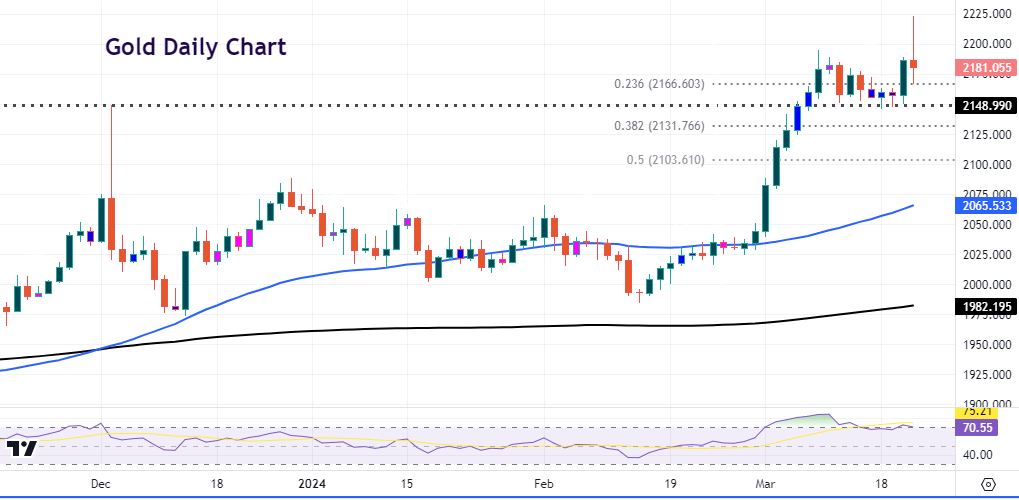Stocks ever higher amid busy central bank activity

Headlines
* Traders embrace Fed’s “Goldilocks” outlook to lift global markets
* SNB surprises with rate cut, moving ahead of the ECB and FOMC
* BoE holds rates but signals on the way to interest rate cuts
* S&P 500 breaks above 5,200 for the first time after near-term Dovish Fed
FX: USD reversed all of its losses after the FOMC meeting, rising back above the 50-day and 200-day SMAs at 103.65/69. Markets have had time to digest the sharp dovish reaction from yesterday. As we said, the uplift in growth, inflation and further-out dot plots potentially means a “higher for longer” rates environment. Weakness in the Swiss franc and yen also helped the Dollar Index. The SNB surprisingly cuts rates by 25bps and that saw USD/CHF shoot over 1.2% higher. US PMIs disappointed, but jobless claims were lower than estimates and the Philly Fed survey beat.
EUR fell back after making a high at 1.0942 early in the day. PMI data was mixed with France notably weak, while German manufacturing sank further into contractionary territory. The region’s composite figure did beat estimates, but manufacturing was lower than expected. The 200-day SMA is at 1.0838. There was a solid bid in EUR/CHF after the shock rate cut by the SNB which helped the broader EUR tone stabilise.
GBP plunged over 1% on the day and below 1.27, after printing an intraday top above 1.28. The BoE stayed on hold but two members who voted for a hike previously switched to no change. Governor Bailey sounded optimistic on inflation with conditions “moving in the right direction”. We see there is only one more CPI and wage data report before the next May meeting, but another two more before the following June meeting. Falling services inflation and wage growth are key for policy easing.
USD/JPY had a 150-pip intraday range. The major has a strong correlation with US 10-year Treasury yields. They dipped and then rebounded off its 200-day SMA. The prior intervention high from October 2022 and peak from October 2023 is at 151.94.
AUD ticked up to 0.6634 early in the European session but gave up gains on dollar strength. This came after super-strong employment data which saw 116.5k jobs added versus 30k expected. The jobless rate also dropped sharply to 3.7% from 4.1%. Money markets pushed their expected start date of the rate cut cycle to September from August. USD/CAD continues to trade around the 50-day and 200-day SMAs. The summary of the BoC’s March policy meeting discussions noted that it was “too early” to cut rates and there was a “diversity” of views among policymakers about the timing of rate cuts.
Stocks: US equities closed higher with record highs encore, this time in all three major indices. The broad-based benchmark S&P 500 closed 0.32% higher to 5241. The tech-dominated Nasdaq 100 added 0.44% to finish at 18,320. The Dow Jones settled 0.68% higher at 39,781. Micron’s upbeat forecast saw the stock soar 16% and caused chipmakers to outperform. Apple declined over 4% after the US Department of Justice filed an antitrust lawsuit against the phone maker. Reddit surged over 47% after its IPO, with the platform raising roughly $750mn from the offering.
Asian futures are in the green. APAC stocks were generally bid after fresh record highs on Wall Street. The initial dovish reaction to the Fed’s dot plot helped the risk mood. The ASX 200 was helped by the blockbuster labour market report. All-time highs in gold saw miners outperform. The Nikkei 225 rallied to fresh peaks above 40,000.
Gold spiked up to $2222 as the dollar and bond yields initially sold off early on after Wednesday’s supposedly dovish Fed meeting.
Day Ahead – Japan releases
National Japan core CPI is expected to tick up to 2.8% y/y in February from the prior 2%. Obviously, this data comes after the BoJ’s historic policy hike but little expectation that more rate rises are coming soon. That said, traders contended with a hawkish sources report yesterday that the BoJ is seen weighing the next rate hike in October or July.
The Rengo, Japan’s largest trade union, releases its second tally on wage negotiations ahead of two more in the following weeks. The first one last week saw Rengo secure the highest wage hikes since 1991. SME figures are now needed to get a broader picture of how all wage deals are shaping up. Aside from earnings, the BoJ is wary of consumption which has been weak.
Chart of the Day – Rejection of higher prices as Gold spikes
Gold has a strong inverse correlation with real bond yields (those adjusted for inflation) and also the dollar. As rates rise, the opportunity cost of holding non-interest-bearing assets like gold becomes less attractive. Similarly, a stronger dollar tends to drive gold price lower while a weak greenback can boost gold prices. That all means monetary policy is critical for gold prices and why we’ve seen sharp volatility over the last 48 hours.
Prices tracked sideways for several days but held strong support at a prior spike high at $2148. We know that the longer prices trade in a narrow range, the bigger the breakout will be. That is normally in line with the long-term dominant trend. Prices broke higher after the FOMC and surged to another record high at $2222. But sellers have slammed gold lower with the metal eventually down 0.2% on the day. The candlestick is a bearish signal and warns of a blow-off top with conditions still overbought.

